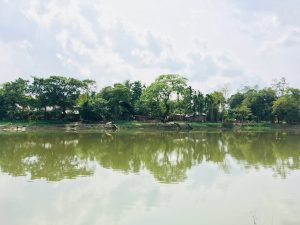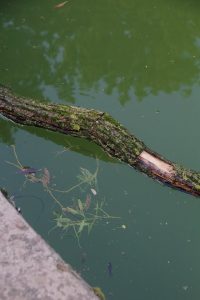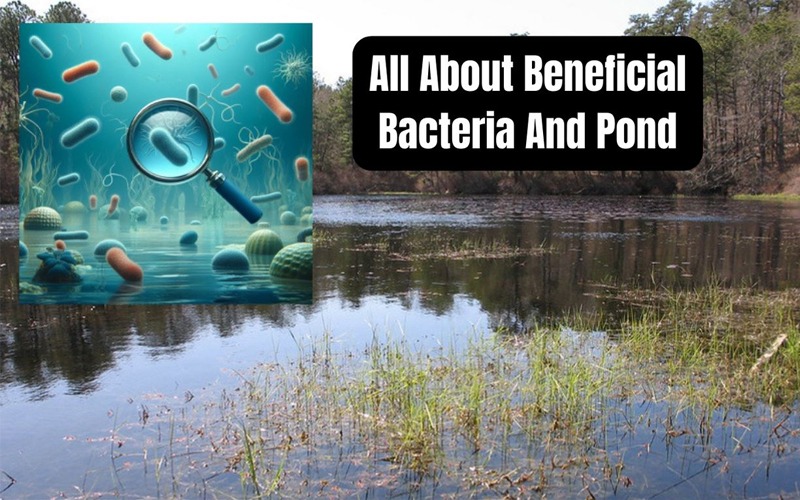Beneficial bacteria for ponds are tiny organisms that play a crucial role in keeping pond water clean and healthy. These helpful microbes thrive in aquatic environments, breaking down fish waste, uneaten food, and other organic matter.
Through a process called the nitrogen cycle, they transform harmful compounds like ammonia into less harmful substances, maintaining a balanced ecosystem.
By adding beneficial bacteria to ponds, especially during warmer seasons, pond owners can enhance water quality and prevent the buildup of harmful substances.
This natural approach contributes to a thriving environment for fish, plants, and other pond inhabitants, promoting overall well-being and sustainability. Regular use of these bacteria helps sustain a stable and vibrant aquatic ecosystem in ponds.
What Role Do Beneficial Bacteria Play In Pond Ecosystems
Beneficial bacteria play a pivotal role in maintaining the health and balance of pond ecosystems. These microscopic organisms contribute significantly to water quality by participating in a natural process known as the nitrogen cycle.
In the nitrogen cycle, beneficial bacteria help break down organic matter, such as fish waste and uneaten food, converting ammonia into nitrites and then into nitrates.
Ammonia and nitrites are harmful to aquatic life, and the bacteria’s conversion process transforms them into less harmful nitrates, which are essential nutrients for plants.
By reducing ammonia and nitrite levels, beneficial bacteria prevent the accumulation of toxic substances in pond water, creating a safer environment for fish and other aquatic organisms.
This bacterial activity also aids in the decomposition of organic debris, preventing the formation of sludge at the pond’s bottom. This, in turn, helps maintain clear water and a healthy habitat for aquatic life.
Moreover, the presence of beneficial bacteria fosters a natural balance in the pond’s ecosystem. They contribute to the breakdown of excess nutrients, such as phosphates, helping control algae growth.
Algae blooms can lead to oxygen depletion and negatively impact water clarity, and the bacteria’s role in nutrient cycling helps mitigate these issues.
Pond owners often introduce beneficial bacteria supplements to kickstart or enhance these natural processes, particularly in newly established ponds or after disruptions like water changes.
Regular application of these bacteria ensures a continuous and stable microbial population, promoting a thriving pond ecosystem that is resilient, balanced, and conducive to the well-being of its inhabitants.
Why Is It Important To Maintain A Balance Of Beneficial Bacteria In Ponds

Maintaining a balance of beneficial bacteria is essential for the health and sustainability of pond ecosystems. These microscopic organisms play a critical role in various processes, from regulating the nitrogen cycle to controlling algae growth.
Understanding the importance of these bacteria sheds light on their vital contributions to pond water quality, the well-being of aquatic life, and the overall ecological balance.
So let’s see the key reasons why it is crucial to ensure a harmonious presence of beneficial bacteria in ponds.
1. Nitrogen Cycle Regulation:
Beneficial bacteria actively participate in the nitrogen cycle, converting harmful compounds like ammonia and nitrites into less harmful nitrates. This process prevents the accumulation of toxins, ensuring a safe environment for aquatic life.
2. Prevention Of Sludge Formation:
By decomposing organic debris, these bacteria prevent the formation of sludge at the pond’s bottom. This not only maintains water clarity but also reduces the risk of oxygen depletion, fostering a healthier habitat for fish and other organisms.
3. Control Of Algae Growth:
Beneficial bacteria play a crucial role in controlling algae growth by breaking down excess nutrients like phosphates. This limits the nutrients available to algae, preventing harmful algal blooms and maintaining the aesthetic and ecological balance of the pond.
4. Water Quality Improvement:
A balanced presence of beneficial bacteria contributes to overall water quality. Clear and healthy pond water is vital for supporting diverse aquatic life, including fish, plants, and invertebrates, promoting a thriving ecosystem.
5. Ecosystem Resilience:
Regular maintenance of beneficial bacteria ensures the natural functioning of the pond ecosystem, enhancing its resilience to environmental changes.
This resilience is critical for long-term health and sustainability, reducing the risk of imbalances and supporting a robust and flourishing pond environment.
So these are reasons why you should maintain a balance of beneficial bacteria on your pond. Hope now you know the importance of beneficial bacteria and ponds.
How Do Beneficial Bacteria Contribute To Water Quality In Ponds
We have already told you what are beneficial bacteria for ponds. And here in this part of this article, we will tell you how do beneficial bacteria contribute to water quality in ponds.
Nitrogen Cycle Regulation:
Beneficial bacteria actively engage in the nitrogen cycle, converting harmful ammonia and nitrites into less harmful nitrates. This conversion prevents the buildup of toxins, ensuring a safe environment for aquatic life.
Ammonia And Nitrite Reduction:
These bacteria play a crucial role in reducing ammonia and nitrite levels in pond water, stemming from fish waste and organic matter. This reduction prevents the harmful impact of these compounds on the pond ecosystem.
Organic Matter Decomposition:
Beneficial bacteria decompose organic debris like fish waste and leftover food, preventing the formation of sludge at the pond’s bottom. This decomposition enhances water clarity and reduces the risk of oxygen depletion.
Nutrient Control For Algae:
By breaking down excess nutrients, especially phosphates, beneficial bacteria help control algae growth. This nutrient control is crucial in maintaining a balanced ecosystem and preventing overgrowth of algae.
Improvement Of Biological Filtration:
These bacteria contribute to biological filtration by colonizing filter media and other surfaces. This enhances the efficiency of natural filtration processes, removing impurities from the pond water.
Prevention Of Foul Odors:
Efficient decomposition of organic matter by beneficial bacteria prevents the release of foul-smelling gases. This contributes to a more pleasant pond environment and indicates a healthy microbial balance.
Can Beneficial Bacteria Prevent The Buildup Of Harmful Compounds In Pond Water

Beneficial bacteria serve as natural guardians against harmful compound buildup in pond water. By actively participating in the nitrogen cycle, they convert ammonia, a potential fish toxin, into less harmful nitrites and nitrates.
Additionally, these bacteria break down organic matter, preventing the accumulation of sludge and debris. Their role extends to controlling nutrient levels, specifically phosphates, limiting the fuel for harmful algae growth.
Through these processes, beneficial bacteria act as biofilters, ensuring a balanced and healthy pond environment by reducing the risk of toxic compounds, maintaining water clarity, and fostering the overall well-being of aquatic life.
When Is The Optimal Time To Introduce Beneficial Bacteria To A Pond
So when to add beneficial bacteria to pond? The optimal time to introduce beneficial bacteria to a pond is during the warmer seasons, typically in spring or early summer.
Warmer temperatures enhance bacterial activity, allowing them to establish and proliferate more rapidly.
As water temperatures rise, the metabolism of both beneficial bacteria and the pond’s inhabitants increases, creating an environment conducive to bacterial growth and nutrient cycling.
This period is ideal for kickstarting the nitrogen cycle and addressing potential imbalances after winter. Introducing beneficial bacteria during this time helps establish a robust microbial community, ensuring efficient breakdown of organic matter, control of nutrient levels, and prevention of harmful compound buildup.
Regular applications throughout the warm months, when bacterial activity is at its peak, contribute to sustained water quality and a thriving pond ecosystem.
It’s essential to follow product instructions and consider specific pond conditions when introducing bacteria for optimal effectiveness in promoting a balanced and healthy aquatic environment.
Are There Natural Ways For Beneficial Bacteria To Establish In Ponds
So here we will tell you what are the natural ways for beneficial bacteria to establish in ponds. If you follow these ways then you can easily establish beneficial bacteria in your pond in the natural way. So let’s see what are the ways.
Natural Colonization:
Beneficial bacteria can naturally find their way into ponds through air, water, and other environmental sources. Wind, rain, and visiting wildlife may introduce bacteria to the pond.
Aquatic Plants:
Aquatic plants play a role in hosting beneficial bacteria. Bacteria can colonize the surfaces of plant roots and submerged plant parts, contributing to the establishment of a microbial community in the pond.
Substrate And Pond Surfaces:
Pond surfaces, rocks, gravel, and substrate provide suitable habitats for beneficial bacteria. These surfaces allow bacteria to attach and form biofilms, creating a stable environment for their growth.
Inflowing Water:
Water flowing into the pond from natural sources, such as streams or underground springs, may bring beneficial bacteria. These bacteria can then establish themselves in the pond and contribute to its microbial balance.
Wildlife Activity:
Wildlife, including birds, amphibians, and insects, can introduce beneficial bacteria to ponds through their activities. For example, birds landing in the water or amphibians moving between ponds can transfer bacteria.
Seasonal Changes:
Changes in seasons, particularly in warmer months, can support the natural establishment of beneficial bacteria. Warmer temperatures enhance bacterial activity and the overall biological processes in the pond.
Can Beneficial Bacteria Help Control Algae Growth In Ponds
Yes, beneficial bacteria play a significant role in controlling algae growth in ponds. By breaking down excess nutrients, particularly phosphates, these bacteria limit the nutrients available for algae, helping prevent overgrowth.
Algae thrive on nutrients, and when these are reduced, the potential for harmful algal blooms diminishes. Additionally, the bacteria contribute to the overall balance of the pond ecosystem, promoting clearer water and healthier conditions for fish and other aquatic life.
While beneficial bacteria alone may not eliminate algae, incorporating them into pond management practices is an effective and natural strategy to control and mitigate excessive algae growth.
How Frequently Should I Add Beneficial Bacteria To My Pond
Here we will tell you how often should I add beneficial bacteria to my pond. Well the frequency of adding beneficial bacteria to your pond depends on various factors such as pond size, fish population, and water conditions.
As a general guideline, adding beneficial bacteria monthly is a common practice, especially during the warmer months when bacterial activity is higher.
Regular applications help maintain a stable population of beneficial bacteria, ensuring continued effectiveness in breaking down organic matter, controlling nutrient levels, and supporting the overall health of the pond ecosystem.
In new ponds or after significant disruptions like water changes, more frequent initial applications may be beneficial.
Regular monitoring of water quality indicators, such as ammonia and nitrate levels, can help tailor the application frequency to the specific needs of your pond, promoting optimal microbial balance and sustained water quality.
Final Words
Hope it’s clear to you what are beneficial bacteria for ponds. Today we have talked all about beneficial bacteria and ponds. If this article seems helpful to you please share it with your friends. Stay connected with us to get informational tips about the pond.





